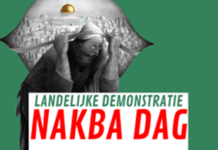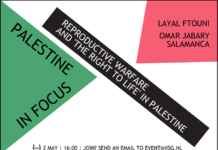Raphael Magarik
Jewish Currents / July 27, 2023
In Invited to Witness, scholar Jennifer Lynn Kelly discusses the political possibilities of Palestinian solidarity tourism.
In 2021, Rep. Jamaal Bowman traveled to Israel with a J Street delegation. The visit, which included a photo-op with right-wing Israeli politician and then-Prime Minister Naftali Bennett, led to calls for Bowman’s expulsion from the Democratic Socialists of America. But Bowman’s trip also included tours that highlighted the conditions of Palestinians living under occupation in the West Bank. Bowman credits the trip with pushing him leftward on Israel/Palestine: Last year, he told constituents he decided to withdraw his co-sponsorship of a bill in support of Israel’s normalization deals with Arab states as a result of the visit.
Bowman’s experience illustrates the centrality of tourism in shaping Americans’ views about Israel and Palestine. Tour options span the political spectrum, from right-wing Zionist junkets for elected officials and Birthright trips for young Jews to a small sector of tourism dedicated to solidarity with Palestinians. In her new book, Invited to Witness: Solidarity Tourism Across Occupied Palestine, American Studies scholar Jennifer Lynn Kelly focuses on this last category, putting Palestinian tour guides at the center of the story.
While the Israeli state uses tourism to strengthen overseas relationships, displace Palestinians, and shore up a narrative of Jews’ exclusive right to the land, solidarity tours tell a very different tale, connecting checkpoints, settlement expansion, the occupation of Jerusalem, the siege of Gaza, and the erasure of Palestinian refugees into one story of settler-colonial dispossession across historic Palestine. Such tours complicate common assumptions about tourism as a shallow and voyeuristic practice; at the same time, they stage meetings of privileged tourists and local subalterns that is itself fraught with colonial power. Kelly suggests that while facing brutal conditions, Palestinian guides nonetheless exercise considerable agency in crafting itineraries and challenging tourists.
I spoke with Kelly about the history of solidarity tourism to Palestine, its political possibilities and ethical challenges, and how Palestinian guides are reimagining tourism. This interview has been edited for length and clarity.
Raphael Magarik: People often think of tourism as shallow, consumerist, and apolitical. How is solidarity tourism different ?
Jennifer Lynn Kelly: In solidarity tourism, guides educate tourists about their context, their conditions, and their freedom struggles. In each of the tours considered in my book—which range from the week-long tours across historic Palestine, to day tours of cities or villages in the West Bank, to two-hour tours in the eastern part of occupied Jerusalem or in West Jerusalem—guides focus on the history of Palestinian displacement and provide an alternative to Zionist narratives. For example, on bus tours through the West Bank, guides will point to sprawling Palestinian terraces and explain how Palestinians have always cared for the land. In doing so, they are intervening in the Zionist idea that Palestine was “a land without a people for a people without a land.” By assembling these kinds of itineraries, the guides are pressing tourism into the service of anti-colonial work.
You show how solidarity tourism functions in part by making tourists aware of its limits. How does this play out?
Tourism often aspires toward authenticity: unfettered access to an unscripted world. That is a consumerist desire. Solidarity tourism is not exempt from this tendency, but it reveals and subverts the script of tourists’ expectations. For instance, in the book I talk about a moment where a tourist was looking at a blackened wall in Nablus and asked, “What happened here?” And the tour guide said, “Someone was spray painting their bed frame.” In these moments, tour guides are interrupting tourists’ desire for a narration of violence and only violence.
Many tourists also expect to be congratulated simply for being in Palestine, but guides instead remind them that the work they need to do is back home, whether it be participating in demonstrations; authoring and presenting “report-backs”; joining Boycott, Divestment, and Sanctions campaigns; or constructing long-term working relationships with Palestinians they met on the tour.
Palestinian solidarity tourism also draws attention to what Israeli rule makes impossible—including a united, continuous Palestinian territory. How do guides contend with the way the Israeli regime divides and segments Palestine ?
Tours of Palestine had to be clandestine until the Oslo Accords [the 1993 and 1995 agreements between Israel and the Palestine Liberation Organization that began the “peace process”]. Oslo formalized tours and professionalized tour guides in service of a potential Palestinian state. But it then escalated a process of fragmentation in the West Bank. Contemporary Palestinian solidarity tourism is thus both a product and a critique of Oslo.
On the tours, guides choose to highlight this post-Oslo fragmentation to show tourists its violence. They stage handoffs that show a continuous Palestinian story interrupted by Israeli barriers. A solidarity tour guide might walk tourists to a checkpoint and say, “I can’t be with you for the rest of the day, you will have another guide in Jerusalem, and I’ll see you this evening.” Through the tour itself, the guides are saying, “You’re allowed to move, and I’m not. You’re allowed to meet guides I’ve never met in person.”
Palestinian tour guides separated from each other by Israeli state violence often must meet outside of Palestine to collaborate. In the book, I discuss how guides from Badil [a resource center that promotes the rights of Palestinian refugees] in the West Bank and Zochrot [an Israeli NGO that disseminates information about the Nakba] in Tel Aviv met in Cape Town to think about their work together.
The Israeli siege of Gaza essentially renders in-person tourism impossible. How do guides respond to this problem?
In Gaza, some guides might walk tourists virtually through their space and answer questions about their conditions. Others use recorded snippets to create a hypothetical tour where they say, “If you were to take a walking tour in Gaza City, here is where I would take you.” There are also virtual tours that help visitors imagine a vibrant, thriving tourism industry in Gaza after liberation. Like solidarity tourism, these virtual experiences are a true refiguring of tourism. The result is not just a camera leading tourists through a space but an exercise in imagining liberation.
What concrete political horizons does solidarity tourism open for the cause of Palestinian liberation ?
When I first started my research, I thought about the political significance of solidarity tourism in terms of how it “responded” to Zionist forms of tourism. I imagined solidarity tourism as chiefly reactive—anti-colonial Christian pilgrimages, for instance, responding to Christian Zionist tourist initiatives.
But in talking to tour guides in Palestine about their work, that “response” paradigm fell apart. I learned that their work was a much more self-referential strategy that started in the First Intifada, with delegations: informal, often clandestine political education trips on which people learned, for example, about the tax boycotts of Beit Sahour and the intifada gardens on rooftops in Bethlehem. On these trips, guests brought many of the same assumptions, desires, and asymmetrical power relations to Palestine as they do today. So Palestinian solidarity tourism is actually a continuation of a form of anti-colonial organizing. Tourists come knowing little about Palestine; they go home and establish long-term connections with Palestinians or join boycott initiatives.
To be clear, solidarity tourism does traffic in colonial violence. In Hebron, tourists are reenacting the segregation they’re critiquing; they can move freely while their Palestinian tour guides’ mobility is deeply restricted. But such tourism is still a useful strategy of resistance for many Palestinians. Tour guides would tell me, “When I first started giving this tour, next to the settlement in Hebron, there was one [Palestinian] shop, and now there are four shops. Those families are resisting displacement.” Tourism anchors the hosts to their lands, despite Israeli attempts to displace them.
Because of restrictions on Palestinian movement, solidarity tourism becomes a way that diasporic Palestinians can, under fraught conditions, access their homeland and gain an anticipatory taste of the right of return. What is that experience like ?
When Palestinians in the diaspora return to Palestine on solidarity tours, often they will not get in. Israel denies entry to Palestinians all the time, and tours can end up illustrating this aspect of the ongoing Nakba. And even though many solidarity tours invite diaspora Palestinians to participate, such guests are often left to fend for themselves. In my book, I talk about a moment when a tour just kept going, knowing that Palestinian group members were going to be detained. That was a moment of failure. The tour was structured around a particular kind of solidarity tourist who was not understood to be a diaspora Palestinian returning to Palestine.
When diaspora Palestinians do manage to enter their homeland, returning as a tourist brings simultaneous pain and joy. The joy is borne out of seeing all of these places that they had only heard of and collecting all narratives to bring home—in other words, acting as an emissary for their family in witnessing the place they had been displaced from. But diaspora Palestinians also told me of the pain of being shuffled through all these places with no time to pause. The pace is often rapid: lecture to tour to meal, with no space for someone to see where their family is from. One tour drove right through the village of one of the participants. They didn’t stop there, but they stopped for [the dessert] knafeh elsewhere.
What is your advice to someone who is going on a solidarity trip to Palestine ?
Tourists to Palestine should ask themselves: Why am I going to Palestine? Am I going because I need to collect evidence, and if so, what do I not see as evidence? What am I ignoring in Palestinians’ narrations of their own condition? I am not saying, “don’t go.” But do read Palestinian literature and scholarship. Don’t let the tour function as an alibi for not doing that research. On the tour itself, pause to reflect: What is my role? What am I being asked to do as a tourist? And what will I do in the wake of the collision between my expectations and what I learned in Palestine?
Raphael Magarik is an assistant professor of English at the University of Illinois at Chicago












